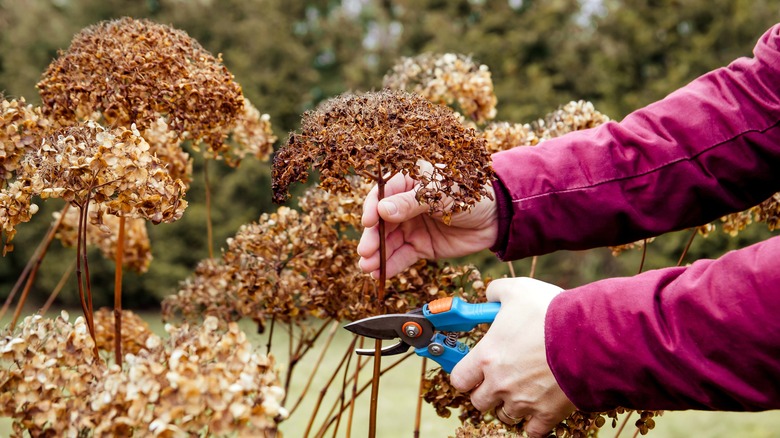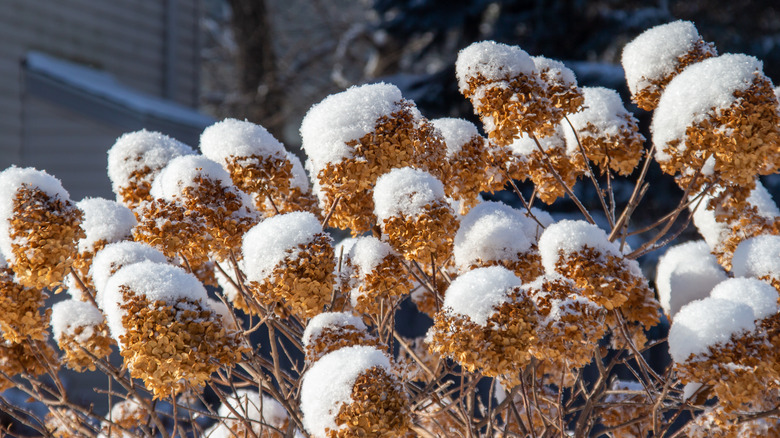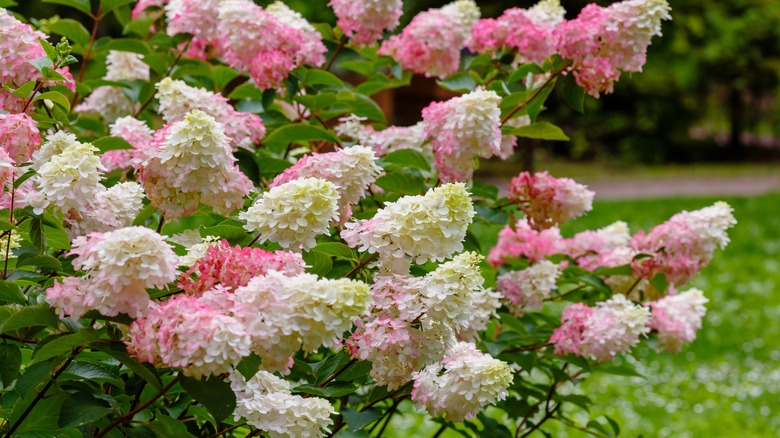The Only Time It's Ok To Cut Panicle Hydrangeas In The Fall
Pruning hydrangeas will prevent them from becoming too woody, directing them to produce bigger blooms instead. However, pruning incorrectly can affect the flowering of your plant. Panicle hydrangeas are usually pruned back during the early spring because the plant flowers on the current year's growth. When the new growth starts to emerge on the stems, you can see exactly where the buds are alive, and you can also see the size of the buds — so the bigger the bud you cut back to, the stronger and more vigorous the growth that comes out of it will be. This essentially means you can make a more informed pruning decision when pruning in spring.
People often prefer to leave the faded flowerheads over winter because they look so charming and can add interest to gardens during the winter when other plants have died back. Others like to leave the plant intact in their garden as a shelter or playground to encourage birds and wildlife to visit. Cutting panicle hydrangeas back in the fall can also have benefits for the plant though, like when there are no buds on the branches, or when the weight of snow and ice could potentially cause damage. Heavy snow and ice may settle or form on the panicles, weighing them down and resulting in unsightly bent or snapped stems. So, if you're expecting extreme weather, pruning back in the fall may be the best way to go.
How to prune panicle hydrangeas in the fall
Before pruning, make sure the plant is completely dormant, meaning it has lost all of the leaves. Dead leaves should come off the plant really easily. If the plant isn't completely dormant, pruning can stimulate new growth during a warm snap in the fall. Remove anything that is decayed.
To prune, you simply shorten back the branches by about one-third of their total length, making sure to cut above a bud. With branches that have several stems coming off them, you can either take off each stem individually, or take the whole main branch back to a bud. When cutting back old stems, make sure to leave around four pairs of buds on each one, as this will encourage more vigorous new growth, resulting in bigger flower heads.
To keep a more classic shrub shape, cut all shoots to a 6-inch stub with about two sleeping eyes — the dormant buds that look like raised dots under the bark. They are where your new shoots will sprout from.
Don't confuse panicle hydrangeas with bigleaf hydrangeas
It's important not to confuse panicle hydrangeas with bigleaf hydrangeas. Panicle hydrangeas have, as the name suggests, 'panicles', which are loose branching clusters of flowers with the separate flowers attached by short equal stalks at equal distances along the central stem. Hydrangea macrophylia, also known as bigleaf hydrangea, is the more common variety of hydrangea plants. In comparison, this species shouldn't be pruned much at all. When it goes dormant, it looks like it should be cut back, but if you do, you will be cutting off the formed flower buds for the following summer, which would be a real shame!
Garden expert Leigh Clapp offers the following advice on deciding when to prune different varieties of hydrangea: "Prune ones that bloom on old growth — lacecap, mophead, and oakleaf — after flowering, and in spring or fall for ones that bloom on new growth — paniculata and arborescens" (via homesandgardens.com.)


